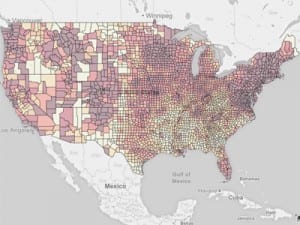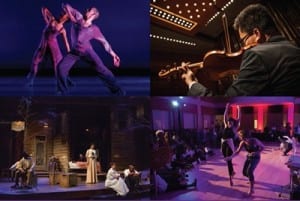While incremental gains were observed, a new study shows that women still hold fewer than 50% of directorships, earn less than male counterparts, and typically lead institutions with smaller budgets
The Association of Art Museum Directors (AAMD) and the National Center for Arts Research (NCAR) at Southern Methodist University in Dallas today released findings from the second iteration of their gender gap study, which was designed to deepen understanding of the gender disparity in art museum directorships to help AAMD member institutions advance towards greater gender equity.
Through a combination of quantitative analysis of 2016 data collected from AAMD member institutions and interviews with female museum directors and executive search consultants who specialize in recruitment for art museums, NCAR and AAMD researchers – led by Zannie Voss, director, NCAR, and Christine Anagnos, executive director, AAMD – examined the ongoing and historical factors of the gender gap in art museum directorships, and compared their findings to those of the previous study, conducted in 2013.
While incremental gains have been observed in the last three years, the study found that the gender gap persists: women still hold fewer than 50% of directorships and, on average, earn less than their male counterparts. The study also found that museum type and budget size were influential factors on representation and salary differentials.
In 2016, AAMD conducted a survey of its members, collecting data from 210 respondents that included each institution’s operating budget, endowment, the salary of the director (or top leader), the director’s gender, and the self-reported museum type (e.g. encyclopedic, contemporary, etc.). Of these 210 museums, 181 also participated in the 2013 survey, allowing for examination of trends. The study sought to answer three main questions: What is the current state of women in art museum directorships? How has the gender gap in art museum directorships shifted in the past three years? What are some factors that may drive the gender gap? The NCAR and AAMD study had several key findings:
- While men continue to outnumber women in director roles, there has been a 5% increase in female directorships from 2013: women represented 48% of art museum directorships in 2016 (compared to 43% in 2013).
- There are clear disparities in gender representation depending on operating budget size: the majority of museums with budgets of less than $15 million are run by a female, rather than a male, director. The reverse is true for museums with budgets of over $15 million, where female representation decreases as budget size increases.
- Women are at a salary disadvantage: on average, female directors earned 73 cents for every dollar that male directors earned.
- When segmented by operating budget, the gender disparities are more nuanced:
For museums with a budget of over $15 million—roughly the top quarter of museums—female directors earned 75 cents for every dollar a male earned, an improvement from 2013, when women earned only 70 cents per dollar earned by a man.
For the other three-quarters of member museums (those with budgets of less than $15 million), female directors on average earned 98 cents to every dollar earned by a man. This represents a reversal from three years ago, when female directors at these same museums earned an average of $1.01 for each dollar earned by their male counterparts. - Women hold the majority of directorships in College/University museums (60%) and Culturally Specific museums (57%). Men hold the majority of directorships at Single Artist (67%), Encyclopedic (59%) and Contemporary (54%) museums.
- Museum types, which are also tied to budget size, also help reveal salary dynamics at play: some museum types with higher average budgets have less of a salary gap as compared to some museums with lower average budget size. The biggest pay disparity is at Encyclopedic museums, where female directors average only 69 cents for every $1 of their male counterparts, while the smallest gap is at Culturally Specific institutions, where women earn 91 cents for every dollar a male director earns.
Drawing from interviews with executive search consultants and female museum directors, the report also includes a qualitative analysis that examines the personal as well as the institutional barriers in achieving gender equality in the field. Overall, interviewees observed that while progress is incremental, the needle is moving, with changes accomplished through cultural shifts within the field and in broader society, and with the emergence of a new generation of leaders.
In addition to Voss and Anagnos, co-authors of the study are Veronica Treviño, SMU MA/MBA Class of 2017, and Alison D. Wade, Chief Administrator, Association of Art Museum Directors. The authors gratefully acknowledge and thank the members of the Association of Art Museum Directors and, specifically, the following art museum directors and executive search consultants for their perspective: Gretchen Dietrich (Utah Museum of Fine Arts), Madeleine Grynsztejn (Museum of Contemporary Art, Chicago), Sarah James (Phillips Oppenheim), Laurie Nash (Russell Reynold Associates), Lisa Phillips (New Museum), Kimerly Rorschach (Seattle Art Museum), Sally M. Sterling (Spencer Stuart), and Belinda Tate (Kalamazoo Institute of Arts).
About AAMD
The Association of Art Museum Directors advances the profession by cultivating leadership capabilities of directors, advocating for the field, and fostering excellence in art museums. An agile, issues-driven organization, AAMD has three desired outcomes: engagement, leadership, and shared learning. Further information about AAMD’s professional practice guidelines and position papers is available at aamd.org.
About NCAR
In 2012, the Meadows School of the Arts and Cox School of Business at SMU launched the National Center for Arts Research (NCAR). The vision of NCAR is to act as a catalyst for the transformation and sustainability of the national arts and cultural community. The goals of the Center are to unlock insights on: 1) arts attendance and patronage; 2) understanding how managerial decisions, arts attendance, and patronage affect one another; and 3) fiscal trends and fiscal stability of the arts in the U.S., and to create an in-depth assessment of the industry that allows arts and cultural leaders to make more informed decisions and improve the health of their organizations. More information about NCAR and its reports, white papers, and tools can be found at smu.edu/artsresearch.




 NASA data leads to rare discovery: Earth’s moon wandered off axis billions of years ago
NASA data leads to rare discovery: Earth’s moon wandered off axis billions of years ago Good news! You’re likely burning more calories than you thought
Good news! You’re likely burning more calories than you thought New look at Pizarro’s conquest of Inca reveals foot soldiers were awed by empire’s grandeur
New look at Pizarro’s conquest of Inca reveals foot soldiers were awed by empire’s grandeur Charity, social justice and earth-friendly activism replace big houses, diamond rings and ostentatious living for status seekers
Charity, social justice and earth-friendly activism replace big houses, diamond rings and ostentatious living for status seekers National Center for Arts Research white paper counters findings of the Devos Institute Study on Culturally Specific Arts Organizations
National Center for Arts Research white paper counters findings of the Devos Institute Study on Culturally Specific Arts Organizations Long-term daily contact with Spanish missions triggered collapse of Native American populations in New Mexico
Long-term daily contact with Spanish missions triggered collapse of Native American populations in New Mexico North America’s newest pterosaur is a Texan — and flying reptile’s closest cousin is English
North America’s newest pterosaur is a Texan — and flying reptile’s closest cousin is English California 6th grade science books: Climate change a matter of opinion not scientific fact
California 6th grade science books: Climate change a matter of opinion not scientific fact Reading ability soars if young struggling readers get school’s intensive help immediately
Reading ability soars if young struggling readers get school’s intensive help immediately







